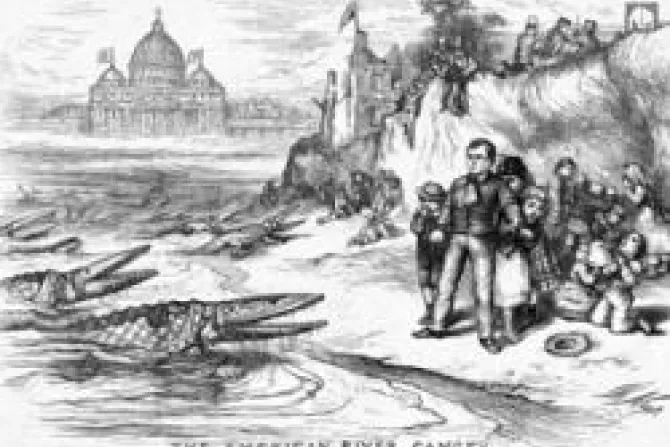Trenton, N.J., Jan 4, 2012 / 23:55 pm
Voting has closed for the New Jersey Hall of Fame’s nomination of 19th-century cartoonist Thomas Nast, whose proposed induction drew criticism from Catholic and Irish groups who said his negative portrayals of Catholics and Irish-Americans made him unsuitable for the honor.
Nast is better known for creating the modern version of Santa Claus and Uncle Sam. He was a pioneer in editorial cartooning and popularized the symbols of the Elephant and the Donkey for the Republican and Democratic parties.
He also created cartoons such as “The American River Ganges,” which show Catholic bishops as alligators threatening schoolchildren. One cartoon, archived at the Catholic League website, labeled the Catholic Church a “foreign reptile.”
Other images attack Catholic opposition to public schooling, which at the time required Catholics to read from the Protestant King James Version of the Bible. One drawing shows monster-faced Irish Catholic schoolchildren kicking a Bible. Another lauds church-state separation in Europe and warns of efforts to unite the institutions in the United States.
The New Jersey Hall of Fame, created through unanimous bipartisan state legislation, is supported exclusively through private donations. Fifty New Jersey residents, living and deceased, are among this year’s nominees.
Nast’s nomination drew criticism from several state legislators and the New Jersey Ancient Order of Hibernians, a Catholic fraternal group for men of Irish descent.
Sean Pender, president of the New Jersey Ancient Order of Hibernians, said in December that Nast’s cartoons portrayed Catholics “in the most stereotypical and unflattering of ways.”
“It is hard to believe that anyone with such a prejudice towards a specific nationality and faith would be singled out for praise,” he said, according to NewJerseyNewsroom.com.
The public vote on the nominees closed on Jan. 1, 2012, the hall’s executive director Don Jay Smith told CNA on Jan. 3.
The Hall of Fame’s board of commissioners reviewed the concerns of the Hibernians and the Catholic League, but felt that they concerned “a very small number of cartoons” drawn over Nast’s “many-decade career,” Smith said.
“When the total body of his work was considered, we’re looking at a handful of political cartoons that were deemed offensive by these two groups.”
The board felt that they would leave the decision to the public.
According to Smith, who said he is not a historian, Nast was very critical of Irish-Americans because of their strong support for his opponents, “the corrupt Democratic political machine of Tammany Hall and Boss Tweed.”
“He was critical of the Catholic Church in two cartoons that he drew because as a progressive at the time, he believed that the Church was not supportive of the separation of church and state, which was an axiom of American life at the time.
“The bishops were campaigning to get children to leave the public schools and go to the newly formed Catholic schools, which were being funded by Boss Tweed.
“Nast didn’t like that, so he was critical in a couple of cartoons of the Catholic Church,” Smith said.
(Story continues below)
“He was a political cartoonist who skewered a lot of people.”
Smith said there was “a lot of misinformation” about Nast’s nomination. He received many e-mails comparing Nast to Hitler and saying he was anti-black. Smith rejected this idea, citing Nast’s support for the emancipation of slaves. Nast may have been critical of 19th-century Irish-Americans because they opposed emancipation, Smith suggested.
He told CNA that the Hall of Fame had been caught off-guard by the controversy because Nast had been nominated for induction for each of the past three ballots.
Smith also noted the Hibernians are also part of the Hall of Fame’s voting academy, but did not raise the issue before.
He said that if Nast fails to win this vote, it is not likely that his name will appear on lists in the near future because he has failed to win induction in the past three years.
“I feel terrible that it became such an issue,” Smith said.



